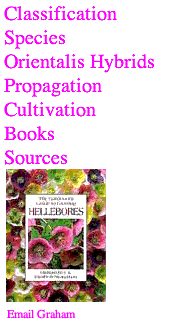

An expanded version of the article in The Garden (February 2001)
Hellebores in North America
In recent years there has been a rapid development of interest in hellebores in North America, the chapter on the subject in my hellebore book represents only the beginning of the story. Breeding is going on in many different parts of the country, with most stock originating in Britain.
Barry Glick of Sunshine Farm and Gardens grows an enormous number of plants. Although he concentrates on Orientalis Hybrids, with 50,000 stock plants on his nursery in West Virginia, he also works with H. foetidus and other species. His Sunshine Strain of Orientalis Hybrids has been developed by careful hand pollination and selection using plants from all the leading European breeders as well as some from New Zealand and Australia. He has good blacks and yellows and picotees and growing so many seedlings allows him a good chance to select superior new forms.
In Washington State Charles Price also started with British stock, originally from Elizabeth Strangman and Robin White with additions of Ashwood and Ballard blood and selected American plants. His yellows, sold through local outlets, picotees (or bicolours as he prefers to call them) and Party Dress doubles are especially good and he also has promising developments in a range of other colours.
Russell and Yvonne Graham in Salem, Oregon are developing their own strains and also retailing a good selection of plants originating in Britain with Graham Birkin alongside a range of other unusual perennials. They are also searching for genuine ‘Christmas’ rose and actively working on Orientalis Hybrids with dark foliage.
In Nova Scotia Ken Shannik and John Weagle at Insigne Gardens raise about 7000 plants a year from seed derived from Ballard, McLewin and Ashwood stock with the addition of selected plants from the widely distributed Royal Heritage strain and blacks from Wanna Reardon-Smith in Devon. They are very wary about naming plants, John’s experience of the rhododendron breeding scene has shown the dangers of being too free with names, but they continue to improve their stock by careful selection and ruthless culling of poor plants.
Dick and Judith Knott Tyler at Pine Knot Farm in Clarksville, Virginia are working on most types of hellebores. Like most American breeders they collected plants from the best British breeders and one of their particular intentions is to bring together beautiful flower colour and form with the best possible foliage. They are also working on doubles and anemone centred forms as well as H. x sternii, H. niger and H. foetidus.
Another source in the hotbed of hellebore fanatics in the pacific North West is Ernie O’Byrne of Northwest Garden Nursery in Eugene, Oregon. They have added fine plants from Charles Price to their European stocks and for the last ten years have aimed for rounded outward facing flowers. Blacks and apricots are a special enthusiasms, they are also working on doubles, and they have also developed a lovely form of H. foetidus, ‘Red Silver’.
In Seattle the garden of Elfie Rahr is stunning. Raiser of the tallest and most vigorous plants you’ll ever see, she grows thousands of plants in her woodland garden and her reds are especially good. As well as vigour she selects for outward facing flowers and unlike many breeders raises most of her seedlings by sowing in the open ground - and has great success.
At nearby Heronswood Dan Hinkley is developing his own strains derived from both British and American stock and the Heronswood Hybrids are now available in six colour groups. At hellebore open day in February there are also plants available from other local suppliers such as Charles Price and Pete Ray or Puget Garden Resources.
Don Jacobs of Eco Gardens in Georgia includes hellebores amongst his range of intriguing plants James W. Waddick in Kansas City breeds for his own satisfaction rather than as a business and is anxious to see really good yellows and continues to appreciate good whites.